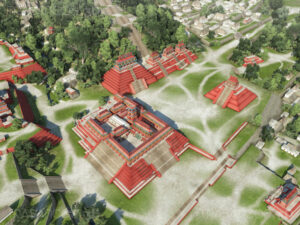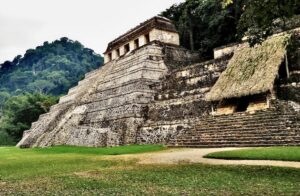
Carved on stone stelae, lintels and painted on ceramics of the Maya Classic period (250-950 AD)*, one sees spouses of lords and other women who were ranking officials in social, political, and spiritual contexts. The history of the Red Queen of Lakamha’ is inseparable from the life of her adopted society in a challenging seventh-century environment riven by conflicts. Lakamha’ in Maya-Ch’ol means “big waters” for the fifty-six streams and small rivers flowing down the slopes of the Chiapas mountain range over natural stair-steps and pools. The city is today known by its Spanish name Palenque, in the Mexican state of Chiapas.
________________________

Central Palenque 650-750AD/CE. @ artstation.com
________________________

Ph.02 – Temple of the Inscriptions-L & Temple.XIII-R. @georgefery.com
________________________
Contributions by women are historically understated in the archaeological record, but have been addressed over recent years, bringing a sharper focus on Maya ancient societies. In the seventh century, the time of our story, hostility led to frequent armed conflicts that were major disruptors in people’s daily lives. Beside securing and raising children, among other important duties, the woman of the family often had to attend to elderly parents or help neighbors in needs. Her husband was either away at the crack of dawn, working in the corn fields (milpas), he may have been ordered to join the army or, between planting and harvesting seasons, summoned by the city leaders to work on major construction projects.
The historical record for the Red Queen’s early life is scarce. However, we know that the society in which she lived was not dissimilar to that of other communities in the region at the time. A brief review of Palenque’s tumultuous history and that of its leading figures will help to set the context leading to her position of great power….
********
In the mid-seventh century, Palenque leaders and those from other communities in the region had to contend with fast drivers of change, among which was a growing population that brought challenges to producing more maize and other edible products. The ensuing need to expand farming areas brought people closer together and forced them to compete for arable land and water. Recurrent severe climate events such as El Niño and La Niña were also major factors in farmers’ migrations, worsening clashes and conflicts. Important socio-economic and political disruptions, among other factors, led heads of large cities and small chiefdoms to search for allies to face up to encroaching powerful rivals. The trade of salt, cocoa beans, cotton, and jade, among other products was carried overland through natural choke points such as rivers and mountain passes guarded by local lords who charged arbitrary taxes. Additionally, the aggressiveness of the powerful Kaan or “kingdom of the snake” of Calakmul to control these choke points and attendant political dominance, was unrelenting. Calakmul was then one of the largest and most powerful kingdoms, located in the greater Petén Basin region, in today’s Mexican state of Campeche.
Young Tz’ak-b’u, the future Red Queen, was playing with her friends when lords and ladies from the great city of Lakamha’ arrived in 599 at Ux te Kuh’, the town of her birth, located mid-way between today’s Palenque and Tortuguero. She could not have imagined then that one of the slender young boys in the refugee party, Janaab’ Pakal, would be her consort for most of her life. How could she?
______________________________
Read the rest of this premium article story at https://popular-archaeology.com/article/the-red-queen-of-palenque/
Image courtesy author Georges Fery





